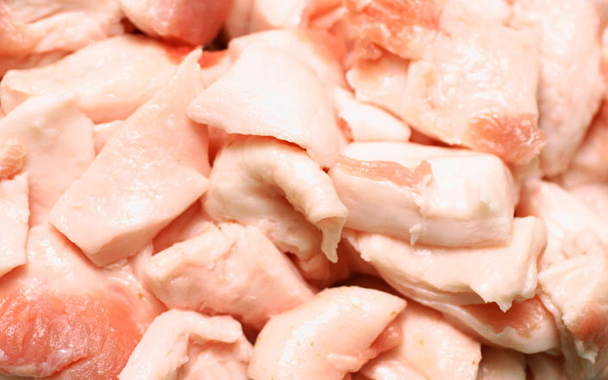We’ve been going through a chicken a week in my house, eating now so we’ll be less bereft when the season for pastured birds ends in the next few weeks. Mostly I roast them but this week, inspired by some beautiful mustard greens, I decided to fry the bird in the Southern style. And that meant I needed to render some lard.
It’s true that you can buy lard packaged in the grocery store, but I don’t bother with the stuff: It’s usually hydrogenated and otherwise stabilized to ensure a long shelf life, and it comes from unhappy industrial hogs. Pastured pig purveyors at the farmers market are happy to sell the raw ingredient for cheap, it takes almost no effort to process, and the resulting lard is brilliant.
Pigs contain two kinds of fat in large amounts: fatback, which lies in a thick layer under the skin, and leaf lard, which is found in big clumps near the kidneys. Fatback is harder, which makes it good for adding to homemade sausages or to cure into lardo, but leaf lard is what you want to render for cooking. I bought a lumpy piece about the size and shape of an entire beef tenderloin (though a whole lot less expensive).
The point of rendering is to extract pure fat and leave behind any water, blood, or bits of meat that might make the fat go rancid, and the way to do this is by heating the fat very gently so it dissolves and the water evaporates, then straining out the leftover bits.
Chop the fat into small, even pieces, or run it through a meat grinder using the coarse plate. If you have time, cover the fat with water and leave it overnight in the fridge, which will extract some of the blood. Drain the fat, put it in a heavy pan with a tiny bit of water, and place the pan in a 225 degree oven uncovered. Then wait. The fat will start to melt, then bubble as the water boils off. Rendering is a slow process: I left my last batch in the oven for four hours, but might have waited even longer. When the fat is entirely rendered, pour it through a chinois or a fine strainer lined with cheesecloth. The fat will cool to a snowy white color, shrinking a lot as it does. (The cracklings left behind in the strainer are tasty, too.) Seal it up against oxygen and it’ll keep forever (I leave it in the fridge, though any cool space works).
Lard, of course, is what Crisco always wanted to be. It’s great for frying because it can get very hot without smoking, but it’s also magnificent in pie crusts, biscuits, cookies, and other pastries, to which it brings a luscious, tender flakiness. You won’t eat a lot of it, but you’ll be happy to have it on hand.




 Pinterest
Pinterest


